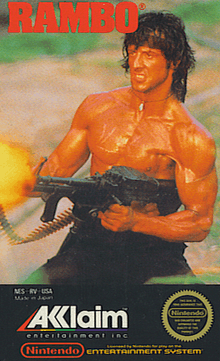Rambo (1987 video game)
Rambo is a side-scrolling action-adventure video game produced by Pack-In-Video for the Nintendo Entertainment System (NES). It was released on December 4, 1987 in Japan, and May 1988 in North America. It is based on the film Rambo: First Blood Part II (1985).
| Rambo | |
|---|---|
 Cover art | |
| Developer(s) | Pack-In-Video[1] |
| Publisher(s) | |
| Designer(s) | Fukuchan Tokita |
| Composer(s) | Tohru Hasabe, Minky Motoyama |
| Series | list of Rambo video games |
| Platform(s) | NES[1] |
| Release | |
| Genre(s) | Action/Platformer,[1] Metroidvania[2] |
| Mode(s) | Single-player |
Gameplay
The game starts off with Colonel Trautman asking Rambo whether or not he wants to leave the prison and start the mission. Players are given a choice, but cannot advance in the game unless "yes" is chosen. Players advance through the camp and talk to others, and when talking to Trautman again, he tells Rambo the mission. Rambo then drops into the forest and fights spiders and other forest creatures. Bosses include giant spiders and helicopters. The game is noted for its identical gameplay to Zelda II: The Adventure of Link, in that the player can kill enemies for experience points and the layouts are similar. In the Japanese version, the experience meter is replaced by an anger meter, however, it functions exactly the same.
Later in the game, Rambo picks up an arsenal of weapons and fights enemy soldiers, but this happens close to the end of the game.
The ending sequence allows the player to throw a giant kanji character (怒, Ikari:Anger) towards Murdock after returning to the base, which inexplicably turns Murdock into a frog.[3][4]
The USA version ends with a simple "End", but the Japanese Famicom version contains staff credits. It is unknown why this was left out of the USA version.[5]
References
- Rambo for NES at MobyGames
- Szczepaniak, John. "Backtracking: The History of Metroidvania". GamesTM (116). Imagine Publishing. pp. 148–53.
- FlyingOmelette.com
- Rambo (NES) Ending
- Rambo Famicom credits screenshots at VGMPF